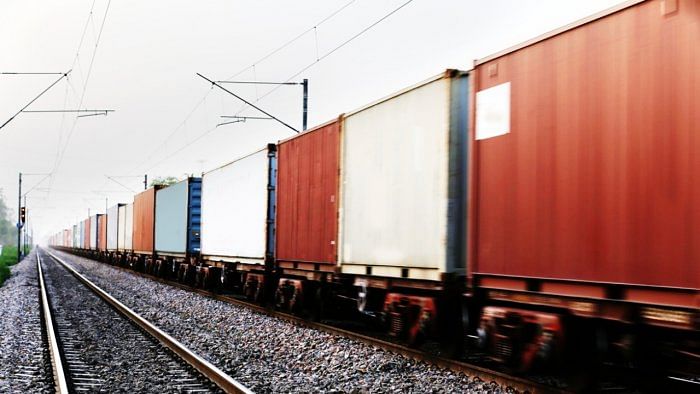
In March 2023, during the last Budget Session of Parliament, railways minister Ashwini Vaishnaw shared the progress of two of the railways’ most ambitious plans, the eastern and western Dedicated Freight Corridors (DFCs).
He had said that so far 66.27 per cent (886 kilometre of the total 1337 Km) of the eastern DFC and 57.30 per cent ( 863 Km of 1506 Km) of the Western DFC has been commissioned with a cumulative capex spending of Rs 99,872 crore.
While these numbers sound impressive, the fact remains that the railways had announced the creation of DFCs in 2005-06. The progress has been steady but slow, and there is much that needs to be done to develop the ecosystem for faster freight transport, and for logistics operators to choose railways over highways for long-distance deliveries.
”Railway freight share might actually drop even further. Except for heavy freight, other freight may move away from trains because of the lowering speed and efficiency of freight trains despite the 2016 target of doubling the average speed of goods and passenger trains,” said Alok Kumar Verma, ex-chief engineer with the Indian Railways Service of Engineers.
“To improve the share of freight traffic by rail, it is critical to strengthen the rail network system and create efficient warehouses,” explained Suprio Banerjee, Vice President & Sector Head - Corporate Ratings, ICRA Limited. “Nevertheless, the pace of the growth in developing the ecosystem shall be dependent on the pace of development in infrastructure activities, and competitiveness of rail freight services.”
According to the National Rail Plan (NRP) 2020, the goal is to increase the modal share of rail to 40%-45% of the logistics market to move 3,600 million tonnes (MT) of cargo by 2030-31. The present share of rail freight stands at 26%, with a recorded freight load of 1,512 MT in FY23.
Rail freight costs the least at Rs 1.6 per tonne kilometre. In comparison, waterways cost Rs 2, roadways stood at Rs 3.6 and air freight topped the list highest at Rs 18, a 2022 report of NITI Aayog revealed.
The IR freight basket is limited and highly skewed vis-à-vis the overall logistics market as it is heavily dependent on coal, iron ore/steel, cement, foodgrain, and fertiliser, contributing almost 74% of freight volume.
“What Indian railways need is a more dynamic and customer-friendly approach to organise commercial customers,” said Vinayak Chatterjee, founder and managing trustee of Infravision Foundation.
While most stakeholders believe that DFCs will reduce transit time and logistics costs, others like Verma believe it is not a sustainable idea owing to poor capacity utilisation.
“DFC is a deeply flawed idea inconsistent with the general practice around the world of constructing new, specifically designed passenger lines to reach higher speeds while utilising the existing lines to carry freight trains and regular passenger trains,” said Verma, adding that what India immediately needs is at least 10,000 Kms of new dedicated passenger lines to meet demand.
“With one network for heavy haul freight trains and a separate disconnected one for bullet trains on standard gauge, the vast IR network will be difficult to operate and where will the money come for three separate networks?,” questioned Verma.
Close to Rs 11,306 crore was allocated for doubling of lines in 2015, out of which only Rs 2950 crore was utilised, data from Budget documents revealed. From 2016, there was a noticeable decline in the funds allotted and funds utilised for doubling and the only time an uptick in funding and utilisation was observed post-pandemic.
The average doubling commissioning between 2009-14 was 375 km per year, which increase to 1394 km per year during 2014-22, a December 2022 press release by MoR suggested. This year about Rs 30,794 crore has been earmarked for doubling of lines.
Experts also argued that rail freight in India is less preferred due to lack of flexibility and last-mile connectivity and emphasised an integrated approach to logistics, which can bring greater visibility and control of the movement of goods and reliability to supply chains.
“Challenges still remain on high turnaround time, adequate and mechanised infrastructure for port sector, poor state of warehousing for storage of goods, high fuel costs, lack of technical and advanced skills etc which needs to be more efficient and cost competitive”, said Banerjee.
Outdated technology and infrastructure, and complex regulatory processes are additional challenges highlighted by global players in this market.
“Countries with well-developed rail freight systems have made significant investments in infrastructure with dedicated freight corridors, modern terminals, and efficient intermodal connectivity,” underlined Vikash Agarwal, Managing Director, Maersk South Asia.
Agarwal said that simplifying and expediting processes related to rail freight operations, including documentation, customs clearance, and intermodal connectivity can further help increase the share of freight through rail in India.
By creatively structuring the public-private partnerships mode to encourage private sector participation, India can increase efficiency, technology adoption, and investment in rail freight infrastructure, opined Chatterjee.